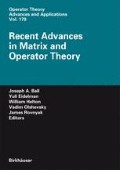Abstract
It has been shown in [4, 5, 6, 31] that the Hessenberg iterates of a companion matrix under the QR iterations have low off-diagonal rank structures. Such invariant rank structures were exploited therein to design fast QR iteration algorithms for finding eigenvalues of companion matrices. These algorithms require only O(n) storage and run in O(n2) time where n is the dimensiosn of the matrix. In this paper, we propose a new O(n2) complexity QR algorithm for real companion matrices by representing the matrices in the iterations in their sequentially semi-separable (SSS) forms [9, 10]. The bulge chasing is done on the SSS form QR factors of the Hessenberg iterates. Both double shift and single shift versions are provided. Deflation and balancing are also discussed. Numerical results are presented to illustrate both high efficiency and numerical robustness of the new QR algorithm.
Access this chapter
Tax calculation will be finalised at checkout
Purchases are for personal use only
Preview
Unable to display preview. Download preview PDF.
References
Mario Ahues and Francoise Tisseur, A new deflation criterion for the QR algorithm, Technical Report CRPC-TR97713-S, Center for Research on Parallel Computation, January 1997.
E. Anderson, Z. Bai, C. Bischof, S. Blackford, J. Demmel, J. Dongarra, J. Du Croz, A. Greenbaum, S. Hammarling, A. McKenney, S. Ostrouchov, D. Sorensen, LAPACK Users’ Guide, Release 2.0, SIAM, Philadelphia, PA, USA, second edition, 1995.
D. Bailey, Software: MPFUN90 (Fortran-90 arbitrary precision package), available online at http://crd.lbl.gov/~dhbailey/mpdist/index.html
D. Bindel, S. Chandresekaran, J. Demmel, D. Garmire, and M. Gu, A fast and stable nonsymmetric eigensolver for certain structured matrices, Technical report, University of California, Berkeley, CA, 2005.
D. A. Bini, F. Daddi, and L. Gemignani, On the shifted QR iteration applied to companion matrices, Electronic Transactions on Numerical Analysis 18 (2004), 137–152.
D. A. Bini, Y. Eidelman, L. Gemignani and I. Gohberg, Fast QR eigenvalue algorithms for Hessenberg matrices which are rank-one perturbations of unitary matrices, Technical Report no.1587, Department of Mathematics, University of Pisa, 2005.
S. Chandrasekaran and M. Gu, Fast and stable algorithms for banded plus semiseparable matrices, SIAM J. Matrix Anal. Appl. 25 no. 2 (2003), 373–384.
S. Chandrasekaran, M. Gu, and W. Lyons, A fast and stable adaptive solver for hierarchically semi-separable representations, Technical Report UCSB Math 2004–20, U.C. Santa Barbara, 2004.
Chandrasekaran, P. Dewilde, M. Gu, T. Pals, X. Sun, A.-J. van der Veen, and D. White, Fast stable solvers for sequentially semi-separable linear systems of equations and least squares problems, Technical report, University of California, Berkeley, CA, 2003.
S. Chandrasekaran, P. Dewilde, M. Gu, T. Pals, X. Sun, A.-J. van der Veen, and D. White, Some fast algorithms for sequentially semiseparable representations, SIAM J. Matrix Anal. Appl 27 (2005), 341–364.
S. Chandrasekaran, M. Gu, X. Sun, J. Xia, J. Zhu, A superfast algorithm for Toeplitz systems of linear equations, SIAM J. Mat. Anal. Appl., to appear.
T.-Y. Chen and J.W. Demmel, Balancing sparse matrices for computing eigenvalues, Lin. Alg. and Appl. 309 (2000), 261–287.
P. Van Dooren and P. Dewilde, The eigenstructure of an aribtrary polynomial matrix: Computational aspects, Lin. Alg. and Appl. 50 (1983), 545–579.
Y. Eidelman and I. Gohberg, On a new class of structured matrices, Integral Equations Operator Theory 34 (1999), 293–324.
Y. Eidelman, I. Gohberg and V. Olshevsky, The QR iteration method for Hermitian quasiseparable matrices of an arbitrary order, Lin. Alg. and Appl. 404 (2005), 305–324.
A. Edelman and H. Murakami, Polynomial roots from companion matrix eigenvalues, Mathematics of Computation 64 (1995), 763–776.
G. Golub and C. V. Loan, Matrix Computations, The John Hopkins University Press, 1989.
J. G. F. Francis, The QR transformation. II, Comput. J. 4 (1961/1962), 332–345.
V. N. Kublanovskaya, On some algorithms for the solution of the complete eigenvalue problem, U.S.S.R. Comput. Math. and Math. Phys. 3 (1961), 637–657.
C. Moler, Roots — of polynomials, that is, The Mathworks Newsletter 5 (1991), 8–9.
V. Pan, On computations with dense structured matrices, Math. Comp. 55 (1990), 179–190.
B. Parlett, The symmetric eigenvalue problems, SIAM, 1997.
B. Parlett, The QR algorithm, Computing in Science and Engineering 2 (2000), 38–42. Special Issue: Top 10 Algorithms of the Century.
G. Sitton, C. Burrus, J. Fox, and S. Treitel, Factoring very-high-degree polynomials. IEEE Signal Processing Mag. 20 no. 6 (2003), 27–42.
M. Stewart, An error analysis of a unitary Hessenberg QR algorithm, Tech. Rep. TR-CS-98-11, Department of Computer Science, Australian National University, Canberra 0200 ACT, Australia, 1998.
F. Tisseur, Backward stability of the QR algorithm, TR 239, UMR 5585 Lyon Saint-Etienne, October 1996.
K.-C. Toh and L. N. Trefethen. Pseudozeros of polynomials and pseudospectra of companion matrices. Numer. Math. 68 (1994), 403–425.
M. Van Barel and A. Bultheel, Discrete Linearized Least Squares Rational Approximation on the Unit Circle, J. Comput. Appl. Math. 50 (1994), 545–563.
J. H. Wilkinson, The algebraic eigenvalue problem, Oxford University Press, London, 1965.
J. Xia, Fast Direct Solvers for Structured Linear Systems of Equations, Ph.D. Thesis, University of California, Berkeley, 2006.
J. Zhu, Structured Eigenvalue Problems and Quadratic Eigenvalue Problems, Ph.D. Thesis, University of California, Berkeley, 2005.
Author information
Authors and Affiliations
Editor information
Editors and Affiliations
Rights and permissions
Copyright information
© 2007 Birkhäuser Verlag Basel/Switzerland
About this paper
Cite this paper
Chandrasekaran, S., Gu, M., Xia, J., Zhu, J. (2007). A Fast QR Algorithm for Companion Matrices. In: Ball, J.A., Eidelman, Y., Helton, J.W., Olshevsky, V., Rovnyak, J. (eds) Recent Advances in Matrix and Operator Theory. Operator Theory: Advances and Applications, vol 179. Birkhäuser Basel. https://doi.org/10.1007/978-3-7643-8539-2_7
Download citation
DOI: https://doi.org/10.1007/978-3-7643-8539-2_7
Publisher Name: Birkhäuser Basel
Print ISBN: 978-3-7643-8538-5
Online ISBN: 978-3-7643-8539-2
eBook Packages: Mathematics and StatisticsMathematics and Statistics (R0)

